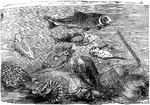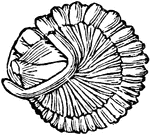Clipart tagged: ‘trilobites’

Paradoxides Harlani
Paradoxides was a genus of relatively large trilobites, extinct marine arthropods, that form the class…

Paleozoic Animals
"Fish, trilobites, brachiopods, corals, and graptolites of the Palaeozoic epoch." -Taylor, 1904

Asaphus Gigas a Trilobite
Asaphus is a genus containing at least 35 species of Ordovician trilobites found primarily in Europe.…

Dicellocephalus Minnesotenis a Trilobite
Trilobites ("three-lobes") are extinct marine arthropods that form the class Trilobita. Why the trilobites…

Dicellocephalus Minnesotenis a Trilobite
Trilobites ("three-lobes") are extinct marine arthropods that form the class Trilobita. Why the trilobites…

Dicellocephalus Minnesotenis a Trilobite
Trilobites ("three-lobes") are extinct marine arthropods that form the class Trilobita.The earliest…